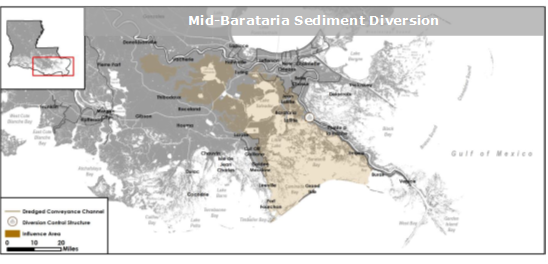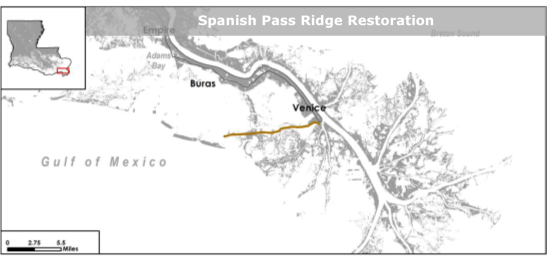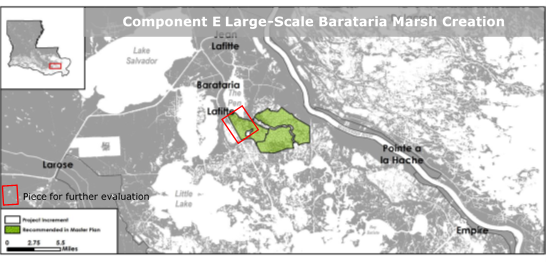A Winning Strategy for Restoring the Barataria Basin
In March 2018, Louisiana’s Natural Resource Damage Assessment (NRDA) Trustee Implementation Group (TIG) released a strategic restoration plan outlining priorities to repair damages and restore the ecosystem in Louisiana’s Barataria Basin following the 2010 Deepwater Horizon oil spill.
The plan, titled, “Strategic Restoration Plan and Environmental Assessment #3: Restoration of Wetlands, Coastal and Nearshore Habitats in the Barataria Basin, Louisiana,” may sound a little dry, but it is actually a big, exciting step forward toward funding and implementing large-scale restoration of Louisiana’s coast.
Where did this plan originate?
In the spring of 2010, shortly after the Deepwater Horizon drilling rig exploded, oil began washing up and coating the beaches and wetlands of the Barataria Basin. Once home to some of the most productive wildlife and fisheries habitat in the nation, the heavily-oiled Barataria Basin is losing land vital to the health and productivity of a wide range of species, in addition to communities and industry.
In 2016, BP agreed to pay $8.8 billion over 15 years with a little over $4 billion of that going to restore damaged wetlands and coastal and nearshore habitats in Louisiana. Since the Barataria Basin was heavily oiled during the spill and because the benefits provided by a healthy, productive Barataria Basin extend to other Gulf resources impacted by the oil spill, the Louisiana TIG decided to develop a restoration strategy specifically for this basin to help prioritize future decisions about restoration project selection and funding.
What is included in the plan?
In this plan, the Louisiana TIG selected an alternative that pursues a suite of restoration approaches for restoring the Barataria Basin, including marsh creation, ridge restoration and a large-scale sediment diversion “that would likely provide benefits to the ecosystem that cannot be realized by any other technique or suite of techniques.” In addition to these restoration techniques, the Louisiana TIG selected three specific Coastal Master Plan projects for further evaluation and planning: the Mid-Barataria Sediment Diversion, the Spanish Pass Ridge Restoration, and part of the Large-Scale Barataria Marsh Creation.
Why were these priorities selected?
An alternative that uses a suite of different restoration project types, including sediment diversions, marsh creation and ridge restoration was selected because:
- “Marsh creation projects can be implemented quickly, targeted to specific locations with currently degraded habitat and have a track record of success within Louisiana.”
- “Ridge restoration projects are intended to reestablish historical ridges…, so implementing ridge restoration helps reestablish the diversity of habitat types that comprise a healthy and functioning Barataria Basin ecosystem.”
- “Large-scale sediment diversions also provide a broader ecosystem benefit, by reestablishing the deltaic processes that deliver sediment, freshwater, and nutrients in a long-term, resilient, and sustainable way. Furthermore, the magnitude of restoration that occurs with large-scale sediment diversions is much larger than other restoration techniques.” Re-establishing the deltaic processes that deliver sediment, freshwater, and nutrients improves the function of existing habitats.”
Together, these restoration techniques would restore a variety of coastal habitat, increase connections between different habitats, and build and maintain marsh and ridge habitat across a large area of the Barataria Basin, accruing greater benefits together than each of these restoration techniques could yield on its own. In addition, “Re-establishing the deltaic processes that deliver sediment, freshwater, and nutrients improves the function of existing habitats.”
What does this mean for Barataria Basin?
While this doesn’t mean these specific projects will be constructed tomorrow, this strategic plan is an important step forward in recognizing the ecosystem-scale benefits that the Mid-Barataria Sediment Diversion project can provide for addressing injuries from the oil spill and restoring long-term health to the Barataria Basin.
In addition to the Louisiana TIG’s clear commitment to Barataria Basin restoration outlined in their strategic restoration plan, here are quotes pulled directly from the plan highlighting the importance of sediment diversions as large-scale restoration mechanisms:
- Despite the high cost of construction, large-scale sediment diversions are anticipated to be more cost effective long-term than other methods of marsh creation and are the only technique capable of producing the full suite of ecological benefits to the Gulf of Mexico ecosystem provided by the reestablishment of deltaic processes.
- Large-scale sediment diversions also have the potential to reduce impacts from relative sea level rise in the Barataria Basin, by providing a sustainable source of sediment to replenish land as it is inundated, thus contributing to long-term resiliency. Thus, the Trustees have concluded that other restoration techniques, such as large marsh creation projects or multiple small-scale sediment diversions, cannot by themselves deliver the same benefits or perform the same functions as an alternative that includes a large-scale sediment diversion.
- Large-scale sediment diversions create significant additional marsh areas and also increase the lifespan of newly created marsh areas by reestablishing hydrologic process that provide a consistent, sustainable source of sediment.
- Large-scale diversions can benefit multiple habitats and resources because they will sustain and create thousands of acres of wetland habitat. The introduction of sediment, freshwater, and nutrients as a result of large-scale sediment diversions would provide ecosystem-level benefits to the entire basin and the Gulf of Mexico.


